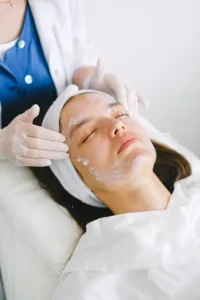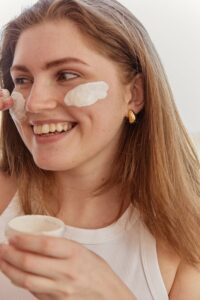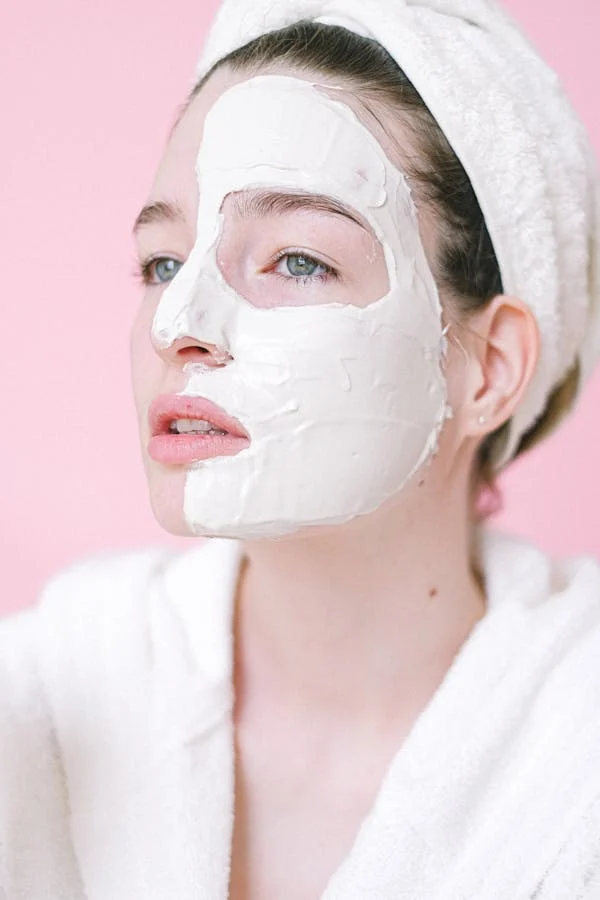Best skincare routine for oily skin
Oily skin can often feel like a challenge, but with the right skincare routine, you can manage excess sebum production, prevent clogged pores, and avoid breakouts. Here’s a detailed step-by-step guide to the best skincare routine for oily skin, along with product recommendations and helpful tips.
Start with a Cleanser
Cleansing is the first and most important step in any skincare routine, especially for oily skin. The right cleanser removes dirt, excess oil, and makeup, helping to prevent clogged pores and breakouts.
What to Look For in a Cleanser for Oily Skin:
- Oil-Free: Choose an oil-free, non-comedogenic cleanser that won’t add excess oil to the skin.
- Gel-Based or Foaming: Gel-based or foaming cleansers are ideal for oily skin because they help remove oil without over-drying the skin. Best skincare routine for oily skin
- Salicylic Acid: A gentle cleanser with salicylic acid helps to penetrate deep into pores to remove oil and prevent breakouts.
Product Recommendations:
- Neutrogena Oil-Free Acne Wash
- CeraVe Foaming Cleanser
- La Roche-Posay Effaclar Gel Cleanser
- The Ordinary Squalane Cleanser(gentle and oil-free)
How to Use:
- Cleanse your face twice daily—once in the morning and once before bed.
- Apply a dime-sized amount of cleanser to damp skin and massage in circular motions, then rinse thoroughly.
Use a Toner
After cleansing, it’s important to balance your skin’s pH level, refine pores, and help control oil production. A toner will remove any residual impurities left after cleansing and hydrate the skin without making it greasy.
What to Look for in a Toner for Oily Skin:
- Alcohol-Free: Alcohol can strip the skin, causing it to produce more oil. Instead, look for alcohol-free formulas.
- Mattifying Ingredients: Ingredients like witch hazel, niacinamide, and tea tree oil help regulate oil production and minimize shine.
Product Recommendations:
- Thayers Witch Hazel Toner(Alcohol-free, soothing)
- Paula’s Choice Skin Balancing Pore-Reducing Toner(Contains niacinamide)
- Pixi Glow Tonic(Contains glycolic acid for gentle exfoliation)
- La Roche-Posay Effaclar Clarifying Solution(Targets excess oil)
How to Use:
- After cleansing, apply toner to a cotton pad and swipe it across your face, focusing on the T-zone (forehead, nose, and chin). Let it absorb into the skin before moving on to the next step.
Apply a Serum
Serums are concentrated treatments that target specific concerns such as excess oil, acne, or inflammation. For oily skin, you should focus on ingredients that regulate oil production and prevent clogged pores.
What to Look for in a Serum for Oily Skin:
- Niacinamide: Reduces sebum production, minimizes pores, and calms inflammation.
- Salicylic Acid: Works to exfoliate and deeply penetrate pores, removing dead skin cells and excess oil.
- Hyaluronic Acid: Hydrates the skin without adding oil, which is essential to maintain balance.
Product Recommendations:
- The Ordinary Niacinamide 10% + Zinc 1%(Regulates oil and minimizes pores)
- La Roche-Posay Effaclar Serum(Contains salicylic acid for acne-prone skin)
- Vichy Mineral 89 Hyaluronic Acid Serum(Provides hydration without clogging pores)
How to Use:
- After toning, apply a few drops of serum to your face and gently pat it on your skin. Let it absorb before applying moisturizer.
Moisturize

Even oily skin needs moisture. Many people with oily skin make the mistake of skipping moisturizer, thinking it will make their skin oilier. In reality, skipping this step can make your skin produce even more oil. The key is to choose the right lightweight, non-comedogenic moisturizer.
What to Look for in a Moisturizer for Oily Skin:
- Oil-Free: Look for gel-based or water-based moisturizers that won’t add excess oil to the skin.
- Non-Comedogenic: Ensure the product is labeled “non-comedogenic,” meaning it won’t clog pores.
- Lightweight Hydration: Choose moisturizers with hydrating ingredients like hyaluronic acid or glycerin.
Product Recommendations:
- Neutrogena Hydro Boost Water Gel(Oil-free and deeply hydrating)
- Clinique Dramatically Different Gel(Gel-based and non-comedogenic)
- CeraVe PM Facial Moisturizing Lotion(Contains ceramides and niacinamide)
- Oil-Free Moisturizer by Vanicream(Perfect for sensitive, oily skin)
How to Use:
- After applying serum, use a dime-sized amount of moisturizer and apply it evenly across your face. Even oily skin needs moisture to stay balanced.
Sunscreen
Sunscreen is essential for protecting your skin from harmful UV rays that can cause premature aging and increase oil production. For oily skin, look for a lightweight, mattifying sunscreen that won’t clog pores or leave a greasy finish.
What to Look for in Sunscreen for Oily Skin:
- Oil-Free and Non-Comedogenic: Ensure that the sunscreen is formulated for oily or acne-prone skin.
- Matte Finish: Choose sunscreens with a matte finish or gel-based formulas to control shine throughout the day.
- Broad-Spectrum Protection: Broad-spectrum protection ensures that you are shielded from both UVA and UVB rays.
Product Recommendations:
- La Roche-Posay Anthelios Clear Skin SPF 60(Oil-free, mattifying sunscreen)
- Supergoop! Unseen Sunscreen SPF 40(Invisible, lightweight, and non-greasy)
- EltaMD UV Clear Broad-Spectrum SPF 46(Great for acne-prone skin)
- Neutrogena Clear Face SPF 55(Non-comedogenic and oil-free)
How to Use:
- Apply sunscreen generously to your face every morning, even if you’re staying indoors. Reapply every two hours if you’re out in the sun for extended periods.
Weekly Treatments (Optional)
In addition to your daily routine, incorporating weekly treatments can further improve your oily skin’s appearance and texture.
Exfoliating Masks:
- Clay Masks: Clay masks, such as those with kaolin or bentonite clay, help absorb excess oil and deep clean the pores.
- Chemical Exfoliants: A mild BHA (salicylic acid) or AHA (glycolic acid) treatment can exfoliate the skin pores.
Product Recommendations:
- Aztec Secret Indian Healing Clay(Great for deep pore cleansing)
- The Ordinary Glycolic Acid 7% Toning Solution(AHA exfoliator for smoother skin)
- Origins Clear Improvement Active Charcoal Mask(Detoxifying clay mask)
How to Use:
- Use these treatments 1-2 times a week. Apply a thin layer to clean, dry skin, and leave it on for 10-15 minutes before rinsing off.
Additional Tips for Managing Oily Skin
- Avoid Over-Cleansing: Don’t wash your face more than twice a day, as over-cleansing can strip the skin, causing it to produce even more oil.
- Use Blotting Papers: Blotting papers can help absorb excess oil during the day without disturbing makeup.
- Don’t Skip Moisturizer: Even oily skin needs hydration. Skipping moisturizer can cause the skin to produce more oil in compensation.
A consistent skincare routine tailored to your oily skin can help balance oil production, prevent acne, and reveal a clearer, smoother complexion. Follow this step-by-step guide, choosing products suited for your skin type, and you’ll soon see noticeable improvements in your skin’s appearance.
With the right cleanser, toner, serum, moisturizer, and sunscreen, you can keep your skin healthy and glowing without the excess shine. Add weekly treatments to boost the effects, and remember, consistency is key for long-term results.
get glowing skincare?

Glowing skin is often associated with a smooth, radiant complexion that looks healthy, hydrated, and vibrant. Whether your skin is oily, dry, or combination, there are key steps and ingredients you can incorporate into your skincare routine to boost radiance and get that glowing skin you’re after.
Understand Your Skin Type
Before starting any skincare routine, it’s crucial to understand your skin type. Knowing your skin’s needs will help you select products that work best for you. Here are the most common skin types:
- Dry Skin: Prone to flakiness, rough texture, and tightness. Needs hydration and moisture.
- Oily Skin: Often shiny with larger pores. Needs oil control and non-comedogenic products.
- Combination Skin: A mix of dry and oily areas. Requires a balanced approach to hydration and oil control.
- Normal Skin: Balanced skin with minimal issues. Needs maintenance and protection.
Tip: Regardless of skin type, glowing skin is about maintaining a healthy, balanced complexion, which requires proper hydration, gentle exfoliation, and nourishing ingredients.
Core Steps in a Glowing Skin Care Routine
A well-rounded skincare routine is essential for achieving glowing skin. Here are the core steps you should follow:
Cleansing
Cleansing is the first step to achieving a glowing complexion. It removes dirt, oil, makeup, and impurities, helping your skin breathe and absorb the products you apply afterward.
Key Tips for Cleansing:
- Use a Gentle Cleanser: Depending on your skin type, choose a hydrating or brightening cleanser. Avoid harsh cleansers that strip the skin of natural oils, as this can cause irritation and dullness.
- Cleanse Twice a Day: Cleansing in the morning and night ensures your skin stays clear and fresh.
Product Recommendations:
- For Dry Skin: CeraVe Hydrating Cleanser, Fresh Soy Face Cleanser
- For Oily Skin: La Roche-Posay Effaclar Gel Cleanser, Neutrogena Oil-Free Acne Wash
- For All Skin Types: Fresh Milk Soy Cleanser, Vanicream Gentle Facial Cleanser
Exfoliation
Exfoliation removes dead skin cells from the surface of your skin, which is key to revealing a brighter, more radiant complexion. It also helps other skincare products penetrate deeper and work more effectively.
Key Tips for Exfoliating:
- Exfoliate 2-3 Times a Week: Over-exfoliating can damage the skin, so limit exfoliation to 2-3 times a week.
- Choose Between Chemical and Physical Exfoliants:
- Chemical exfoliants(like AHA or BHA) are gentle and work to dissolve dead skin cells.
- Physical exfoliants(like scrubs) should be used sparingly and with caution to avoid irritation.
Product Recommendations:
- For All Skin Types: The Ordinary Glycolic Acid 7% Toning Solution, Paula’s Choice Skin Perfecting 2% BHA Liquid Exfoliant
- For Sensitive Skin: Pixi Glow Tonic, L’Oréal Paris Revitalift Bright Reveal Brightening Peel Pads
Toning
Toning helps restore the skin’s natural pH balance, especially after cleansing and exfoliating. It can also help tighten pores and prepare your skin for better product absorption.
Key Tips for Toning:
- Choose Alcohol-Free Toners: Alcohol can dry out and irritate the skin, leading to dullness.
- Hydrate and Brighten: Look for toners with brightening ingredients like vitamin C, niacinamide, or rose water.
Product Recommendations:
- For Hydration: Klairs Supple Preparation Unscented Toner, Neutrogena Alcohol-Free Toner
- For Brightening: Paula’s Choice Enriched Calming Toner, Thayers Witch Hazel Toner
Serums
Serums are lightweight but highly concentrated formulas designed to target specific skin concerns, such as dullness, dark spots, or uneven texture. Adding a serum packed with brightening and hydrating ingredients can significantly enhance your glow.
Key Ingredients to Look for in Serums for Glowing Skin:
- Vitamin C: Brightens the complexion, reduces dark spots, and evens out skin tone.
- Niacinamide: Helps reduce redness and brightens skin, while minimizing pores.
- Hyaluronic Acid: Hydrates the skin, plumping it up and giving it a dewy finish.
- Retinol: Encourages cell turnover, improving skin texture and tone.
Product Recommendations:
- For Brightening: SkinCeuticals C E Ferulic, La Roche-Posay Pure Vitamin C Face Serum
- For Hydration: The Ordinary Hyaluronic Acid 2% + B5, Vichy Mineral 89 Hyaluronic Acid Face Serum
- For Even Skin Tone: Murad Rapid Age Spot and Pigment Lightening Serum
Moisturizing
Moisturizing is essential to maintaining glowing skin. Even if you have oily skin, don’t skip this step. A good moisturizer will keep your skin hydrated and ensure that it doesn’t produce excess oil in response to dryness.
Key Tips for Moisturizing:
- Use a Lightweight, Hydrating Moisturizer: Gel-based or water-based moisturizers are ideal for oily or combination skin, while richer creams may be more suited to dry skin.
- Look for Ingredients That Lock in Moisture: Ingredients like glycerin, hyaluronic acid, and ceramides help to retain moisture and keep skin hydrated.
Product Recommendations:
- For Dry Skin: CeraVe Moisturizing Cream, Neutrogena Hydro Boost Water Gel
- For Oily Skin: La Roche-Posay Effaclar Mat, Clinique Dramatically Different Gel
- For All Skin Types: Vanicream Daily Facial Moisturizer, Belif The True Cream Aqua Bomb
Sunscreen
Sunscreen is non-negotiable when it comes to achieving glowing skin. Sun exposure can lead to dark spots, wrinkles, and skin damage, dulling your complexion. SPF protects your skin from harmful UV rays and ensures that your skin stays healthy and glowing.
Key Tips for Sunscreen:
- Use SPF 30 or Higher: Always use sunscreen with an SPF of at least 30.
- Look for Broad-Spectrum Protection: This protects against both UVA and UVB rays.
- Choose Oil-Free or Matte Sunscreens for Oily Skin: If you have oily skin, choose a sunscreen that is lightweight and won’t clog pores.
Product Recommendations:
- For Dry Skin: EltaMD UV Daily Broad-Spectrum SPF 40, La Roche-Posay Anthelios Melt-in Sunscreen Milk SPF 60
- For Oily Skin: La Roche-Posay Anthelios Clear Skin SPF 60, Supergoop! Unseen Sunscreen SPF 40
Additional Tips for Glowing Skin
- Stay Hydrated: Drink plenty of water throughout the day to keep your skin hydrated from the inside out.
- Get Enough Sleep: Your skin repairs itself overnight, so adequate sleep is crucial for a radiant complexion.
- Eat a Skin-Friendly Diet: Include foods rich in antioxidants, vitamins, and omega-3s, such as fruits, vegetables, nuts, and fatty fish.
- Exercise Regularly: Physical activity boosts circulation, which can contribute to a healthy glow.
- Avoid Stress: Stress can lead to skin issues like acne and dullness. Practice relaxation techniques to help maintain healthy skin.
Common Mistakes to Avoid
- Skipping Sunscreen: UV exposure accelerates aging and can lead to pigmentation issues, making your skin look dull.
- Over-exfoliating: Too much exfoliation can damage your skin barrier, leading to dryness and sensitivity. Stick to 2-3 times a week.
- Using Harsh Products: Avoid overly harsh products that can strip your skin of its natural oils and lead to irritation.
- Neglecting Night Care: Your skin regenerates at night, so it’s essential to use nourishing products before bed.
Conclusion
Achieving glowing skin involves more than just the right skincare products—it’s about maintaining a consistent routine, staying hydrated, and caring for your skin both internally and externally. By following the steps above, choosing the right ingredients, and taking care of your overall health, you can achieve that radiant, glowing skin you’ve always desired.
FAQ About Glowing Skin
How can I get glowing skin in a week?
- Start by following a consistent skincare routine, exfoliate 2-3 times a week, and hydrate both internally (by drinking water) and externally (using a hydrating serum and moisturizer).
Can I get glowing skin if I have oily skin?
- Yes! Use oil-free products that focus on hydration, exfoliation, and sun protection. Look for non-comedogenic products to avoid clogging pores.
What foods promote glowing skin?
- Foods rich in vitamins C, E, and omega-3 fatty acids, such as citrus fruits, avocados, nuts, and leafy greens, promote glowing skin.
Is it okay to use vitamin C daily?
- Yes, vitamin C is a powerful antioxidant that can be used daily to brighten skin and protect against free radical damage. Just ensure you’re using a formula that suits your skin type.
Does sleep really affect skin glow?
- Absolutely! Quality sleep helps your skin repair and regenerate, leading to a healthier, more radiant complexion.

